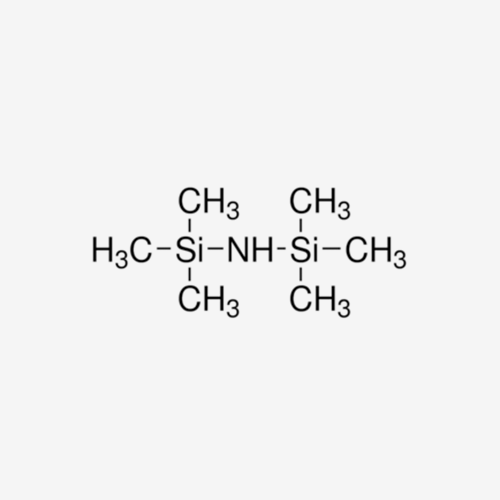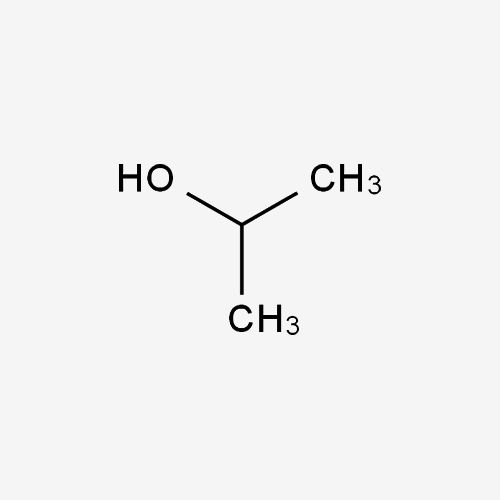Hexamethyldisilazane (HMDS)
Hexamethyldisilazane, commonly abbreviated as HMDS, is an organosilicon compound with the chemical formula (CH3)3SiNHSi(CH3)3. It is a clear, colorless liquid with a faint ammonia-like odor. HMDS is primarily used as a surface modifier, offering a wide range of applications across various industries.
Hexamethyldisilazane is an N-silyl compound obtained from ammonia by replacement of two of the hydrogens with trimethylsilyl groups. Hexamethyldisilazane is a derivatization agent used in gas chromatography & mass spectrometry applications. It derives from a hydride of ammonia. With Glindia, you can develop various chemical reactions and optimized pathways for production.
Formula:
C6H19NSi2
Synonyms of HMDS:
Hexamethyldisilazane
Bis(trimethylsilyl)amine
HMDS
1,1,1,3,3,3
Hexamethyldisilazane
Hexamethyldisilazane (HMDS)
- Chemical Structure : HMDS features two silicon atoms bonded to three methyl groups and one imino group each, imparting unique chemical properties.
- Physical State : HMDS is typically found in liquid form at room temperature, with a boiling point of approximately 126°C.
- Reactivity : HMDS is highly reactive due to the presence of silicon-nitrogen bonds, making it suitable for surface modification and functionalization.
- Hydrophobicity : HMDS-treated surfaces exhibit excellent hydrophobic properties, repelling water and other polar substances effectively.
What are the Applications of HMDS (Hexamethyldisilazane):
HMDS is widely used as a surface treatment agent for silicon wafers in semiconductor fabrication processes. It serves as a hydrophobic adhesion promoter, facilitating the deposition of photoresist materials during photolithography.
In analytical laboratories, HMDS is employed as a derivatization reagent for enhancing the volatility of polar compounds prior to gas chromatography (GC) analysis. This derivatization process improves compound detectability and separation efficiency.
HMDS finds applications in various organic synthesis reactions, particularly in the preparation of silyl ethers and silazanes. These reactions utilize HMDS as a reagent to introduce silicon-based functionalities into organic molecules.
HMDS can be utilized in surface coatings to impart hydrophobic properties to substrates such as glass, ceramics, and metals. Treated surfaces exhibit enhanced resistance to moisture, corrosion, and environmental degradation.
HMDS is employed in polymer chemistry to modify the surface properties of polymers, enhancing their adhesion, wettability, and compatibility with other materials.
In biological and medical research, HMDS is utilized for surface modification of microfluidic devices, biosensors, and medical implants to improve biocompatibility and functionality.
What are the Benefits of HMDS (Hexamethyldisilazane):
Versatility
HMDS offers versatility in surface modification applications across multiple industries, providing tailor-made solutions for diverse requirements.
Enhanced Performance
Treated surfaces exhibit improved properties such as hydrophobicity, adhesion, and chemical resistance, leading to enhanced performance and durability.
Cost-Effectiveness
HMDS treatments offer a cost-effective solution for surface modification compared to alternative methods, thereby optimizing production processes and reducing overall manufacturing costs.
Compatibility
HMDS is compatible with a wide range of substrates and materials, ensuring seamless integration into existing manufacturing processes.
Ease of Application
HMDS can be applied using various methods including vapor deposition, dip coating, spin coating, and spray coating, offering flexibility and ease of implementation.
What are the Safety Considerations for HMDS (Hexamethyldisilazane):





HMDS should be used in a well-ventilated area to prevent inhalation of vapors.
Personal protective equipment such as gloves, goggles, and lab coats should be worn when handling HMDS to prevent skin contact and eye irritation.
HMDS should be stored in a cool, dry place away from direct sunlight and incompatible materials.
In case of spillage, absorbent materials should be used to contain and clean up the spill, and appropriate disposal procedures should be followed.
Hexamethyldisilazane (HMDS) is a versatile chemical compound with numerous applications in surface modification across various industries. Its unique properties, coupled with its ease of application and cost-effectiveness, make it an indispensable tool for enhancing the performance and functionality of diverse materials and substrates. However, proper handling and safety precautions must be observed to ensure safe use in industrial and laboratory settings.
We Provide Best in class service and on time delivery to fulfill the requirement of this product worldwide.





